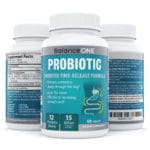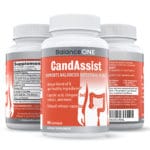Getting Started On Your Candida Diet

You’ve discovered that you have Candida overgrowth and you want to start a Candida diet. Where do you begin?
On this page, I’m going to describe a simple Candida treatment plan that will work for most people.
The Candida diet itself is very important. The latest research shows that diet is a vital part of beating intestinal Candida overgrowth. (1)
However, most people need more than just diet to beat their Candida. Candida albicans is a uniquely adaptive pathogen that can evade your immune system in numerous ways.
There are several examples. Candida albicans builds protective biofilms, or matrices, that allow it to hide from your immune system. It can switch between yeast and fungal forms, depending on the pH of its environment. It can even change the pH of its surrounding environment, to allow it to switch to its more aggressive, fungal form. And it physically changes its cell walls in acidic environments. (2, 3, 4)
All of these factors make Candida albicans an extremely tough opponent. That’s why an intestinal Candida overgrowth can be particularly difficult to beat.
If you’re looking for a really detailed, comprehensive plan to beat your Candida, I recommend our Ultimate Candida Diet program. I created it with Dr Eric Wood, and it contains all our latest recommendations.
Our program uses a 5-step, 60-day timeline that is designed to beat a Candida overgrowth and avoid Candida die-off. It also includes comprehensive shopping lists and more than 100 tasty, Candida diet recipes. You can read more about it here.
Here are the basics of the plan that we recommend. Let’s get started!
Table Of Contents
Step 1: Eliminate Risk Factors for Candida
What caused your Candida? Was it a course of antibiotics? A high-sugar diet? Chemical exposure? Other medications like oral contraceptives or antacids?
Sometimes a gut imbalance like Candida can be caused by a single thing. Other times it’s a combination of things.
The first step to recovery is identifying the factors that might have led to your Candida overgrowth, and eliminating them.
Before you start changing your diet and introducing supplements, try to remove the triggers that might have caused your Candida in the first place. Try to reduce your stress levels, improve your diet, and speak to your doctor about your medications.
When you start the Candida diet and take supplements to improve your gut health, you don’t want anything holding you back. Fix these issues now, and you’ll have a much better chance of beating your Candida.
You can read more about the causes of Candida here.
Step 2: Switch to the Anti-Candida diet
Candida albicans thrives on a diet full of added sugars. It needs sugar to survive, to build its cell walls, and to transform into the fungal form that allows it to spread. (5, 6)
The most important part of the anti-Candida diet is simple – cut all added sugars out of your diet. That means no more candy, store-bought breakfast cereal, or sugary condiments.
Once you start looking at nutrition labels, you’ll be shocked at how much added sugar you’ve been eating.
Sugar is a pro-inflammatory food, which brings me on to my next point. On your anti-Candida diet, you also need to avoid foods that will increase gut inflammation.
An intestinal Candida overgrowth is itself inflammatory, so you don’t want the food you eat to make it worse.
Inflammatory foods to avoid include all processed foods and foods containing gluten. You also need to minimize the amounts of caffeine and alcohol that you consume.
Some foods are particularly good for gut health and will help to reduce your gut inflammation. These include fermented foods like probiotic yogurt, wild fish that are rich in omega-3 fatty acids, and pseudo-grains like buckwheat.
You can read more about the anti-Candida diet here.
Step 3: Take a Good Probiotic
It’s impossible to overstate the importance of probiotics as part of your Candida treatment plan.
Flooding your gut with probiotic bacteria is a crucial part of recovering your gut health, fighting Candida, and restoring your gut flora to a healthy balance. (7, 8)
Fermented foods can be a big help too – they’re rich in probiotic bacteria and are very easy to digest. But most of their bacteria are destroyed by stomach acid. Taking a good probiotic supplement will give your microbiome the boost that it needs.
When you buy a probiotic supplement, make sure that it will deliver its bacteria to your gut. Most commercial probiotics are a waste of money – they only deliver around 4% of their bacteria past stomach acid.
 I recommend the Balance ONE Probiotic, which I helped to formulate. It uses technology to compress the probiotic bacteria into tablets, meaning that around 60% of them will survive past stomach acid (that’s 15 times better than regular probiotics). It’s the only probiotic that I recommend for Candida, and you can read more about it here.
I recommend the Balance ONE Probiotic, which I helped to formulate. It uses technology to compress the probiotic bacteria into tablets, meaning that around 60% of them will survive past stomach acid (that’s 15 times better than regular probiotics). It’s the only probiotic that I recommend for Candida, and you can read more about it here.
Whichever probiotic you choose, make sure it has at least 10 billion CFUs of bacteria and at least 5 different strains (including L. acidophilus). Most importantly, make sure that it will get its bacteria past stomach acid and to your gut.
You can learn more about probiotics here.
Step 4: Use Natural Antifungals
Lastly, we come to antifungals. You can think of them as the attack troops of your Candida treatment. They work by breaking down and destroying the cell walls of Candida albicans yeast cells.
There are a wide variety of natural antifungals that have been shown to inhibit and reverse Candida activity. There are also prescription antifungals, like Diflucan, but these tend to come with lots of side-effects.
Good examples of natural antifungals include caprylic acid, berberine, and undecylenic acid. You can take them in supplement form. You can even integrate antifungals into your diet too – foods like coconut oil, garlic, and rutabaga have quite powerful antifungal properties. (9, 10, 11)
 Taking two or three antifungals is a good idea because it prevents the Candida from adapting to a single antifungal. An easier solution is to use a combination antifungal that contains several antifungals in a single dose. I recommend the CandAssist formula from Balance ONE, and you can read more about it here.
Taking two or three antifungals is a good idea because it prevents the Candida from adapting to a single antifungal. An easier solution is to use a combination antifungal that contains several antifungals in a single dose. I recommend the CandAssist formula from Balance ONE, and you can read more about it here.
You can read more about natural antifungals here.
What About Candida Die-Off?
It’s tempting to jump in and do all these steps at the same time. What could go wrong? Well, quite a lot actually!
When lots of yeast cells die at the same time, they release lots of the toxic chemicals that are store inside them. This can lead to something called a Herxheimer reaction, which is a dramatic worsening of your Candida symptoms.
One of the most important parts of your Candida treatment plan is avoiding a die-off reaction. You can do this in two ways.
First of all, take your time! Introduce one part of the program at a time, then wait. If you feel good after a week or two, it’s probably OK to move on to the next step. Listen to your body and don’t be tempted to move too fast.
Second, help your body to detox itself. Drinking lots of water will help, as will other therapies like saunas and regular exercise.
Dr Eric and I also recommend some herbal supplements and minerals that will help your liver to process and expel Candida toxins. If possible, take two or more of these to give your liver the support that it needs.
I recommend using a supplement like Liver One, which contains liver-supportive ingredients like milk thistle extract and molybdenum. Read more about it here. Supporting your liver can give you relief from your Candida symptoms and minimize the chance of Candida die-off.
Take the Next step
I’ve included lots of free information about Candida overgrowth on this website. You can find information on creating your Candida diet, choosing a probiotic, preventing Candida die-off, and much more.
If you need more guidance, I would suggest looking at our Ultimate Candida Diet treatment plan. It uses a 5-step, 60-day timeline that is designed to beat a Candida overgrowth and avoid Candida die-off.
I designed the program along with Dr Eric Wood. It contains almost 500 pages of information about beating Candida, together with more than 100 recipes that are perfect for your Candida diet.

3-Month Candida Elimination Kit Start Your 3-month Candida Cleanse
This Candida Kit contains all the supplements recommended on the Candida Diet:
- LIVER ONE to process and remove the toxins created by Candida.
- CANDASSIST to inhibit and weaken the Candida colonies in your gut.
- PROBIOTIC to replace the Candida yeast with probiotic bacteria.
Plus... the CANDIDA DIET RECIPE BOOK with 50+ low-sugar recipes

I have been having reoccurring yeast infections for years and my doctor continues to give me Diflucan. I would like to receive emails to help me defeat this Candida
Hi Larissa, I just added you to our email list 🙂
Hi Lisa I have just been found out that I have candida and have been given a seven day course of Diflusole. I would love to receive your e-mails.
Many thanks Lucy
Thank you,